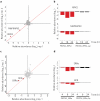Catalytic in vivo protein knockdown by small-molecule PROTACs
- PMID: 26075522
- PMCID: PMC4629852
- DOI: 10.1038/nchembio.1858
Catalytic in vivo protein knockdown by small-molecule PROTACs
Abstract
The current predominant therapeutic paradigm is based on maximizing drug-receptor occupancy to achieve clinical benefit. This strategy, however, generally requires excessive drug concentrations to ensure sufficient occupancy, often leading to adverse side effects. Here, we describe major improvements to the proteolysis targeting chimeras (PROTACs) method, a chemical knockdown strategy in which a heterobifunctional molecule recruits a specific protein target to an E3 ubiquitin ligase, resulting in the target's ubiquitination and degradation. These compounds behave catalytically in their ability to induce the ubiquitination of super-stoichiometric quantities of proteins, providing efficacy that is not limited by equilibrium occupancy. We present two PROTACs that are capable of specifically reducing protein levels by >90% at nanomolar concentrations. In addition, mouse studies indicate that they provide broad tissue distribution and knockdown of the targeted protein in tumor xenografts. Together, these data demonstrate a protein knockdown system combining many of the favorable properties of small-molecule agents with the potent protein knockdown of RNAi and CRISPR.
Figures





Comment in
-
Protein-slaying drugs could be the next blockbuster therapies.Nature. 2019 Mar;567(7748):298-300. doi: 10.1038/d41586-019-00879-3. Nature. 2019. PMID: 30894734 No abstract available.
References
Publication types
MeSH terms
Substances
Associated data
- PubChem-Substance/251963825
- PubChem-Substance/251963826
- PubChem-Substance/251963827
- PubChem-Substance/251963828
- PubChem-Substance/251963829
- PubChem-Substance/251963830
- PubChem-Substance/251963831
- PubChem-Substance/251963832
- PubChem-Substance/251963833
- PubChem-Substance/251963834
- PubChem-Substance/251963835
- PubChem-Substance/251963836
- PubChem-Substance/251963837
- PubChem-Substance/251963838
- PubChem-Substance/251963839
Grants and funding
LinkOut - more resources
Full Text Sources
Other Literature Sources
Medical

